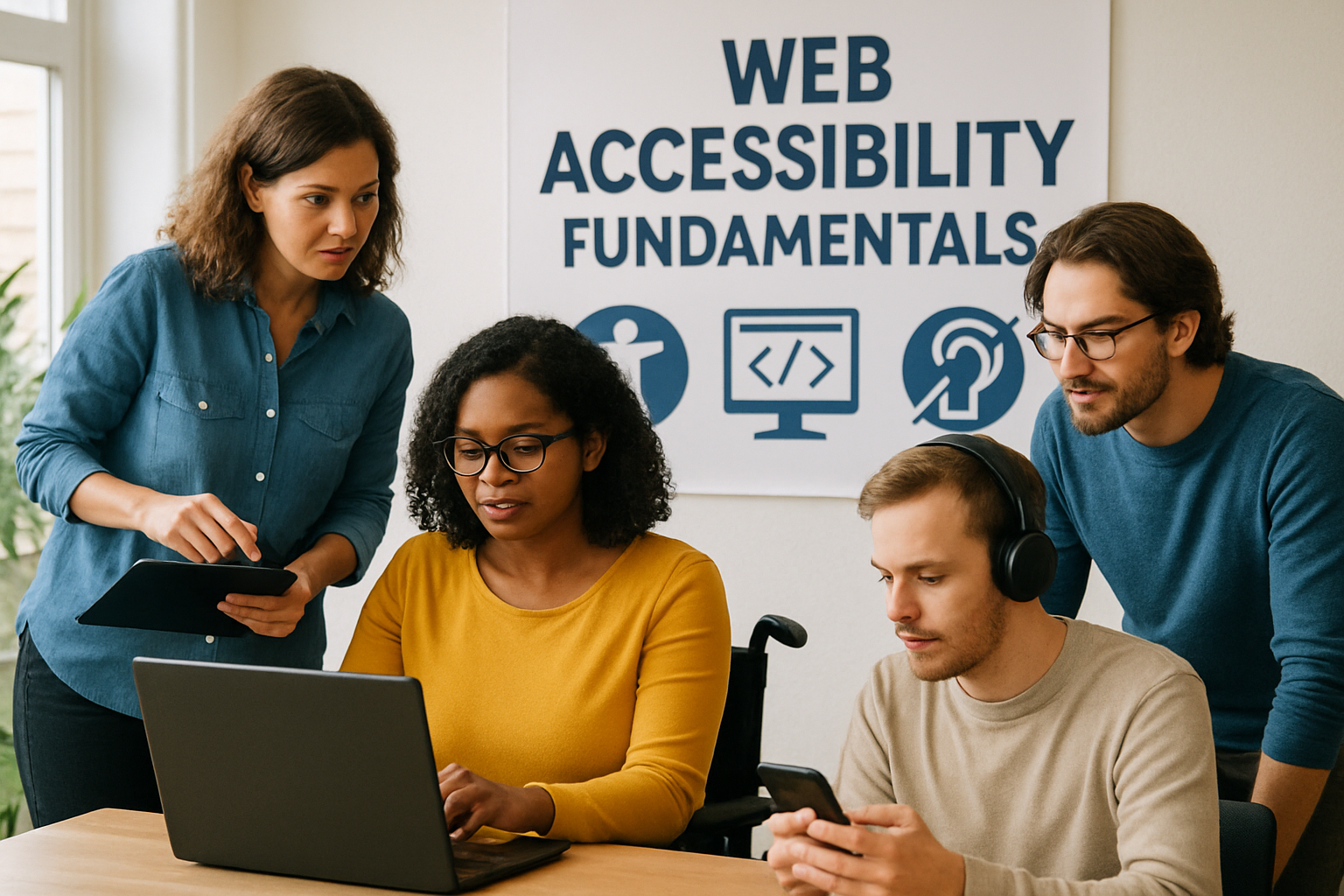
Web accessibility fundamentals
Web accessibility is not a mere checkbox for compliance—it’s an ethos that shapes how we design, build, and communicate online. By prioritizing inclusivity, we ensure that the digital world remains open to everyone, regardless of their abilities, background, or neurodiversity. With an ever-growing emphasis on digital presence in education, technology, and the workplace, understanding the fundamentals of web accessibility is essential for anyone contributing to the web.
What is Web Accessibility?
Web accessibility means that websites, tools, and technologies are designed and developed so that people with disabilities can use them. More specifically, people can perceive, understand, navigate, and interact with the Web, and they can contribute to the Web.
Accessibility is not about making things easier for people with disabilities—it’s about making things possible.
Accessible design benefits everyone: improved user experience, better SEO, faster site performance, and broader reach. For organizations, it also means compliance with legal requirements such as the Americans with Disabilities Act (ADA) and Europe’s Web Accessibility Directive.
The Four Principles of Accessibility: POUR
The WCAG (Web Content Accessibility Guidelines) are built around four core principles, summarized by the acronym POUR:
- Perceivable – Information and user interface components must be presentable to users in ways they can perceive (e.g., text alternatives for images).
- Operable – User interface components and navigation must be operable (e.g., keyboard navigation).
- Understandable – Information and the operation of the user interface must be understandable (e.g., clear instructions and predictable navigation).
- Robust – Content must be robust enough to be interpreted reliably by a wide variety of user agents, including assistive technologies.
Actionable Examples of Accessibility in Practice
Let’s look at how these principles translate into practical steps for creating accessible web experiences.
1. Alternative Text for Images
Images should never be the sole way to convey information. Use the alt attribute to describe images succinctly and meaningfully.
- Decorative images should have empty alt text (
alt=""), so screen readers skip them. - Informative images need descriptive alt text, e.g.,
alt="Woman coding on a laptop in a bright office".
Tip: Avoid redundancy. If the image is already described in surrounding text, keep the alt attribute empty.
2. Semantic HTML
HTML was designed to describe the structure of content, not its appearance. Using semantic elements like <header>, <nav>, <main>, <section>, <article>, and <footer> helps assistive technologies interpret the content correctly.
- Use
<h1>–<h6>for headings, in logical order. - Structure lists with
<ul>,<ol>, and<li>. - Mark up tables properly with
<th>and<caption>for clarity.
Good semantic markup is the foundation of any accessible website.
3. Keyboard Accessibility
All interactive elements—links, buttons, forms—must be usable via keyboard alone. For many people with motor disabilities, keyboard navigation is the only way to interact with content.
- Tab order should be logical and predictable.
- Use
<button>elements for actions, not<div>or<span>. - Avoid keyboard traps: users must be able to move focus away from any element using only the keyboard.
Try it yourself: Navigate your website with only the Tab key. Can you reach every link, button, and form field?
4. Color and Contrast
Color should never be the only means of conveying information. Approximately 1 in 12 men and 1 in 200 women have some form of color vision deficiency.
- Ensure a contrast ratio of at least 4.5:1 for normal text and 3:1 for large text.
- Don’t use color alone to indicate required fields or errors in forms—use symbols or text as well.
- Test designs with color blindness simulators for better empathy.
Accessible color palettes not only improve usability but also make your site look more professional and modern.
Accessible Forms: Beyond the Basics
Forms are among the most complex and critical elements for accessibility. They require careful attention to labels, instructions, error messages, and validation.
Labels and Instructions
Every form input must have a descriptive <label> element. Placeholders are not a substitute for labels.
- Associate labels with inputs using the
forattribute. - Provide clear instructions before users fill out the form, not just after errors occur.
Validation and Error Messages
Let users know what went wrong and how to fix it without relying solely on color. Use clear, concise language and make sure error messages are announced by assistive technology.
“Please enter a valid email address” is more helpful than “Error!”
Accessible Patterns for Neurodivergent Users
Neurodivergent people—including those with ADHD, autism, or dyslexia—may have unique needs when interacting with forms and interfaces.
- Break long forms into smaller, manageable steps.
- Use plain language and avoid jargon.
- Provide context for each section and give feedback on progress.
- Use sufficient spacing and avoid distracting animations or time limits.
Empathy-driven design is about understanding that accessibility is not one-size-fits-all. Neurodiversity is an essential part of the human experience, and digital spaces should reflect that.
ARIA: When and How to Use It
Accessible Rich Internet Applications (ARIA) attributes allow developers to make complex widgets accessible when native HTML isn’t enough. But, as the saying goes, “No ARIA is better than bad ARIA.”
- Use native HTML elements wherever possible.
- Apply ARIA roles, states, and properties only when necessary (e.g., custom modal dialogs or tabs).
- Test ARIA implementations with screen readers and keyboard navigation.
ARIA can unlock accessibility for advanced components, but misuse can break basic functionality for users who rely on assistive tech.
Testing and Tools: Ensuring Accessibility
Automated tools can catch many accessibility issues, but nothing replaces real user testing. A combination of techniques yields the best results.
Automated Tools
- WAVE
- axe
- Lighthouse (built into Chrome DevTools)
These tools highlight missing alt text, poor color contrast, missing labels, and other common problems.
Manual Testing
- Use screen readers (NVDA, VoiceOver, JAWS) to experience your site as blind users do.
- Navigate entirely by keyboard to ensure every function is accessible.
- Zoom in to 200%+ to check for responsive, readable layouts.
- Simulate color blindness and other visual impairments with browser extensions.
Invite people with disabilities and neurodivergent users to test prototypes and provide feedback. Their lived experience is invaluable.
Inclusive Content and Communication
Accessibility is not just about code. The words we choose, the way we structure information, and the tone we use all impact accessibility.
- Write in plain English. Avoid unnecessary jargon and explain acronyms.
- Break up long paragraphs with headings, lists, and images (with alt text).
- Use descriptive link text: “Download the accessibility guide” instead of “Click here”.
- Provide captions and transcripts for audio and video content.
- Respect language and cultural differences by offering multilingual options when possible.
Inclusive content is clear, concise, and respectful. It helps everyone—not just people with disabilities—learn and thrive.
The Intersection of Accessibility, Technology, and Career
As the tech industry evolves, accessibility skills are increasingly in demand. Whether you’re a developer, designer, content creator, educator, or advocate, understanding web accessibility fundamentally enriches your career.
- Developers who master accessibility build more robust, future-proof applications.
- Designers who champion inclusive UX create products that serve diverse audiences.
- Content creators who write accessibly reach broader, more engaged communities.
- Educators who teach accessibility empower the next generation of digital leaders.
For women, neurodivergent professionals, and other underrepresented groups in tech, accessibility is not just a professional asset—it’s a core value that aligns with inclusion and empowerment.
Building a Culture of Accessibility
Accessibility is a journey, not a destination. Start by learning the basics, then integrate accessibility into every stage of your workflow—from planning and design to development and quality assurance.
- Advocate for accessibility in your team and organization.
- Stay updated with the evolving standards (WCAG 2.2, upcoming 3.0).
- Share knowledge and mentor others: accessibility is everyone’s responsibility.
- Celebrate progress, but never stop improving.
“The power of the Web is in its universality. Access by everyone regardless of disability is an essential aspect.”
—Tim Berners-Lee
Web accessibility is more than a technical checklist—it’s an act of care and respect for our entire digital community. By embracing these fundamentals, you’re not just making the web more usable; you’re making it more human.


